Services
Repair & Rebuild Services
Lehmann Mill's Repair Advantages
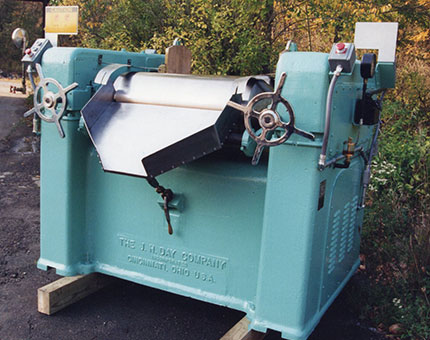
Lehmann Mill's Repair Services
The quality of Lehmann’s repair workmanship is unsurpassed. Lehmann provides customers with a specialized reconditioning and modernizing service for any brand/model mill. Through the Lehmann repair program, our employees have had the privilege to view all our competitors’ equipment. From tear-down to final re-assembly, we have had the opportunity to see how all these mills are manufactured and, also, test them in production. These experiences have afforded us with extensive knowledge of mill designs and technology.
One of the reasons that Lehmann mills have gained such favor is precisely because of their durability. Our unique mill designs, and the energy channeled into building or reconditioning a quality mill is crucial to produce the finest particle size, and the most effective blending, resulting in a constant grade of excellence.
Lehmann's mill repairs are performed specifically for each roller mill. Substandard repairs are never considered. Our repair process is specifically matched to the sensitivity of each mill.
What you can't see can hurt you!
New seals over corroded or grooved shafts and sleeves, gears which are topped for clearance - creating improper tooth profiles, end plates with extensions, "knurling" the shaft to improve bearing fit, welds to the roll surface. These are only a few examples of poor repair techniques we have encountered from other repair facilities, in an attempt to offer you a low cost repair. Techniques like these inevitably lead to improper mill operation, added maintenance, and product leakage - wasting your time and money.
In the event your mill part is too severely damaged for restoration, Lehmann will equip your mill with a new custom replacement part.
What does it cost?
Quotations are FREE. Equipment thought to be obsolete or for which repairs are unobtainable can be back in operation fast, saving time and expenses.
Peace of mind!
All repairs are undertaken to the highest standards. Lehmann cannot afford to cut corners on repair processes, and risk the trust our customers have placed with us.
Next step!
If you have any questions about our service, and would like a free quotation, please contact us at Lehmann Mills.
Quality Reconditioning

Before Reconditioning

After Reconditioning
The process begins with a thorough inspection of your mill, followed by a complete report detailing the materials and labor required for reconditioning. Cost estimates may be tailored to fit your budget, and a schedule worked out to ensure as little downtime and interference with your production as possible.
Reconditioning Typically Includes:
- Complete tear down of the unit, with all parts chemically and mechanically cleaned
- Roll crowns calculated and reground
- Side shields re-machined and recut to conform to new diameters
- All gears inspected and recut to conform to new diameters
- Bearings replaced
- Cooling and lubrication systems inspected and returned to top efficiency
- Gauges, dials and indicators repaired or replaced as needed
- All motors and controls completely renovated and updated
Once the process is complete, a Lehmann Mills field representative can instruct your personnel in proper operation and maintenance of the unit to ensure continued long life and productivity.
Reconditioning your roller mill will return it to like-new condition and maximize your original investment.
Custom-Designed Upgrades
Our upgrade developments are designed to improve safety and production with existing mills. Lehmann has introduced instrumentation that monitors processing conditions such as temperature, pressure level, and speed. Feeding this information to our programmable controller allows constant adjustments to the processing condition. Lehmann's automation upgrades can result in consistent, reproducible, and uniform dispersion of products.
PLC/Electronic Control Packages
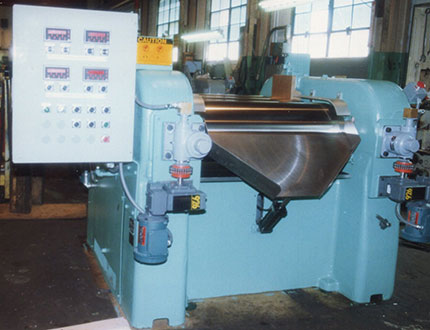
PLC/Electronic Control Packages
Using in-house CAD engineering, we custom-design a control package to suit your specific need or application.
Generally included in the control package:
- Automatic control system for roll and knife pressures
- Automatic temperature control system
- Hopper level control system
- Data collection monitoring system
Benefits from a custom-designed upgrade or addition of a PLC/Electronic control design include:
- Enhancement of mill grinding procedures through simplified automatic control
- Improved production efficiency
- The ability to maintain consistent milling parameters
- Increased reliability of milling operations
- The ability to save and recall data regarding roll temperature and pressure
- Decreased set-up time
Control packages are available as a retro-installation during a mill repair as pictured, or as an optional feature on new Lehmann Mills.
Electro-Hydraulic Controls
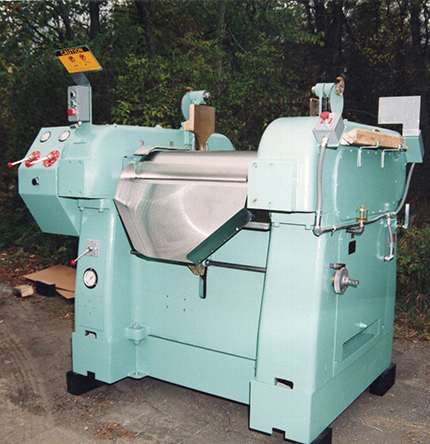
Standard
Electro-Hydraulic
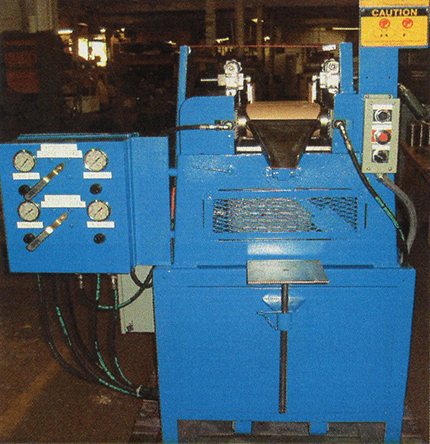
Electro-Hydraulic
4-Point Control
Hydraulic operation achieves maximum roll force for the hardest grinding products. Four-point adjustment and easy to read pressure gauges provide repeatability to improve quality and increase productivity. This mill enhancement provides push-button control of the roll force. By positioning the control valves the rolls can be controlled simultaneously with equal pressure on each roll, or independently, with the ability to set individual roll pressures.
General Automatic Control System with "VFD"
Mill Operation:
- Automatic or manual control of roll, knife pressures.
- Automatic or manual control of mill roll speeds, batch number fault and alarm messages.
The Control Station shall enable an operator to select from any of ten programs, provided by HMI licensed software. Each program shall be able to control operating parameters and product feed equipment throughout the entire batch run.
Control all required milling parameters through the entire batch being milled. During milling operations, the control shall maintain all parameters within acceptable industry standards.
Prior to the control package activating the mill, the operator will be able to manually assign a batch or lot number to the load about to be milled. Operating data will be stored and accessible by batch number for later review from a PC. The mill operation shall not be able to be initiated by the program control until the batch number has been entered and the operator has pressed a key communicating to the control it is now OK to turn on the program.
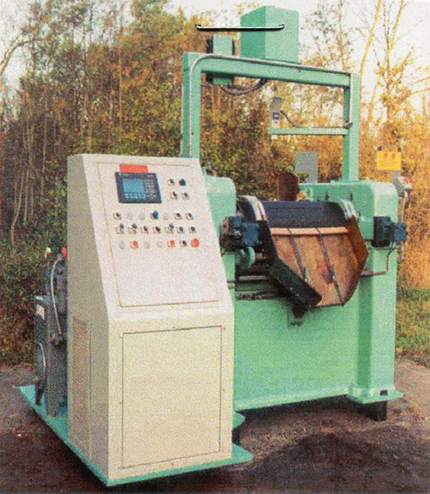
Electro-Hydraulic with PLC Control
Package 14" x 30" Day Mill
Operator keys in or selects a specific program which has pre-set mill and feed parameters. The parameters the program must control through the batch cycle are:
- Desired mill (roll) speeds
- Desired feed roll pressure, PSI
- Desired apron roll pressure, PSI
- Desired apron roll engagement
- (Permit) temperature, if desired
- Main roll operating temperature F/C degree
- Main roll high temperature fault (limit)
- Desired knife pressure, PSI
- Hopper level to stop mill if product level is too low
- Engage the feed roll
- Load hopper with material
- Start main drive motor in mixing speed
- Make fine adjustments, if desired, to feed roll for even material distribution
- Select desired mode, automatic or manual
- Engage knife to the apron roll
- Engage the apron roll
- Make fine adjustments, if desired, to apron roll
Motor: A 50 HP (37.3 KW}, 1200 RPM variable frequency motor, 440 Volt, 3 Phase, 60 Hz, and controls are recommended, depending upon the speed and/or application with electric overload protection. Other voltages are available.
Digital Control Package
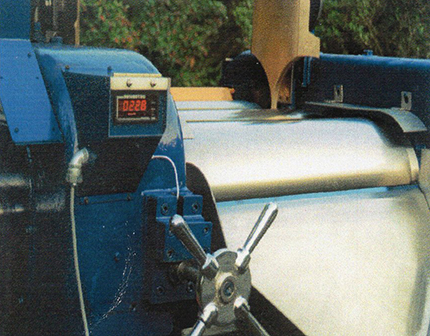
Digital Load Cell
Digital Load Cell Readouts
Load cells provide accurate digital read-outs, combined with the simplicity of manual roll adjustment. Operators no longer need to rely on sight or feel to achieve optimal mill capability.
Digital Temperature Control Packages
Consisting of the following features:
- Individual roll temperature control
- Nema 4X control panel
- Thermal couples
- Water valves
- Special water pipes
- Packages for most mill designs
This fully field configurable controller combines advanced hardware design and sophisticated electronic technology into a compact, reliable package. The Smart self-tuning feature automatically adjusts the controller to rapidly respond to all process changes. Precise control results in holding tighter temperatures and typically provides better reproducibility and consistency in the process.
During start-up, the Smart self-tuning function calculates the control parameters to optimize the rise to set point. During process control, parameters are updated as needed to respond to set point changes.
Anti-Backlash, Motorized Machine Screw Actuator Roll Adjustments
Powered through worm gear reducers, 1/4 H.P. motors are coupled to the actuator roll adjustments at each end of the feed and take-off rolls, controlled by "Pressure Release" push buttons, which are mounted in an operator's control panel. Four programmable digital read· outs provide the roll settings of the feed and take-off rolls allowing precision adjustment of the roll positions in increments of .001", at the push of a button. A field programmable indicator controls roll travel limitations. A non-volatile memory retains the programs in the event of a power interruption.
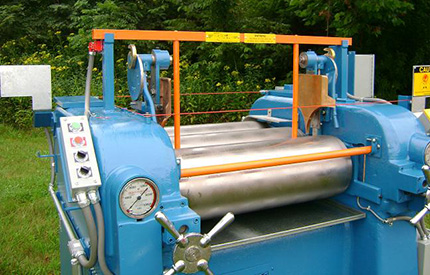
ANSI Safety Upgrades
Three Roll Mill ANSI Safety Standard
Safeties:
Mill will comply with ANSI Std. B65/NAPIM177.1-2007.
Nip point guard/wash-up stick interlock, per clause 10.2, consisting of: Nip point guard with integral keyed safety switch, preventing the mill from operating in any speed other that wash-up mode. The keyed safety switch will be wired to the emergency stop circuit and should the nip guard be removed or disconnected, the mills "Emergency Stop" feature will activate.
Mechanical mill guarding will be provided with "Tamper Resistant" fasteners and necessary removal tool for maintenance, per clause 9.1
Audible alarm provision per clause 13.5.3 provides necessary terminal connections and wiring diagram to add an audible alarm. Note: Does not include alarm, relay, controls, etc.
Emergency stop stations with yellow background per clause 7.2.2, wash-up mode per clause 8.4 and emergency braking per clause 8.5.
See ANSI safety standards, 865/NAPIM 177.1.2007 for complete explanation.
Safety Package, Designed for All Three Roll Mills
- Nip point / wash-up stick interlock
- "Life-line" cable safety
- Body bar (slow roll guard)
- Emergency braking
- Feed roll interlock for mill run mode
- Wash-up mode (for safe clean-up)
Maintenance Reminder
Preventative maintenance is the key to the long and productive life of your roller mill. We supply maintenance instructions with our machine manuals, and in following these instructions, expensive repairs can be avoided. Lehmann mills are designed to run in a 24-hour environment, but they do require periodic maintenance to assure reliable production.
Drive Adjustment - Every 2-3 months, remove vent panels and inspect the drive. Tighten any loose nuts & bolts. Replace the rubber shock mounts· under the adjustment eyebolts, if necessary.
Apply pressure on the apron roll and check the slack in the silent chain. Slack should be approx. 3/4". Adjust the motor base as necessary.
Roll Adjustment - Sight-0-Matics - If the hand wheel must be turned more than 1/2 a revolution before effectively moving the roll, then it is low in hydraulic oil. All roll adjustments are protected by shear pins or shear discs to prevent damage to the rolls. If your adjustment will not respond to pressure, check the shear pin or shear disc and replace as necessary.
Hydraulic (if applicable) - Check oil level in hydraulic pump reservoir and add oil if necessary. If oil must be added often, check the system for leaks.
Lubrication:
- Gear Reservoirs - Check oil levels every day. Add oil if necessary. Clean and replace oil once a year.
- Bearings - Grease bearings after every 400 hours of running time.
- Motor Bearings - Re-pack motor bearings once a year. See motor manufacturers service literature.
- Chain Oiler - Adjust chain oiler to drip one glass full of oil every 40 hours of running time. Drain used oil from pan under the chain as necessary.
- Pneumatic - Add oil to lubricator on pneumatically controlled aprons as necessary.
- Hydraulic Mills - Maintain proper oil level in hydraulic pump reservoirs.
**IMPORTANT NOTE: Sludge buildup in the gear case, caused by gear wear and bearing grease, may plug the end of the dip stick, or level gauge, causing a false reading. Make sure the dip stick, or level gauge, is clear of sludge and change the oil in the gear case when sludge buildup occurs.
For questions, or concerns, about any brand of roller mills in your facility, please do not hesitate to contact us.
